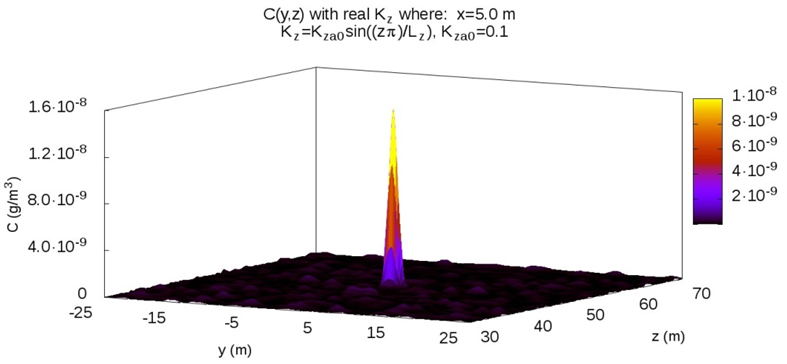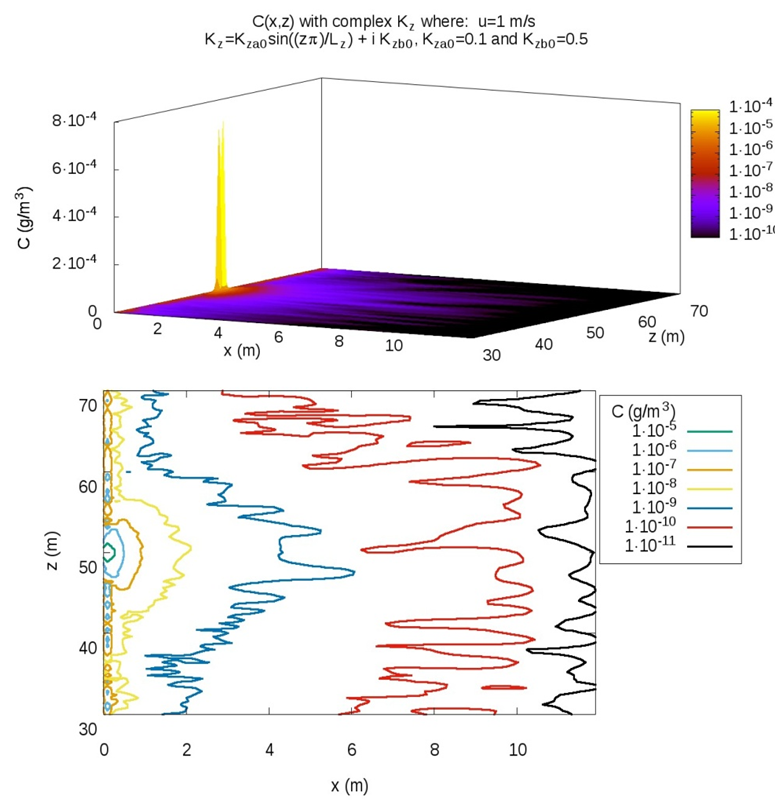-
Paper Information
- Previous Paper
- Paper Submission
-
Journal Information
- About This Journal
- Editorial Board
- Current Issue
- Archive
- Author Guidelines
- Contact Us
American Journal of Environmental Engineering
p-ISSN: 2166-4633 e-ISSN: 2166-465X
2016; 6(4A): 160-163
doi:10.5923/s.ajee.201601.23

A Genuine Solution of the Diffusion Advection Equation Sesquilinear Way to Multi-Source Problem
Débora Lídia Gisch1, Bardo E. J. Bodmann2, Marco T. M. B. Vilhena2
1Graduate Program in Mechanical Engineering, Federal University of Rio Grande do Sul, Porto Alegre, Brazil
2Federal University of Rio Grande do Sul, Porto Alegre, Brazil
Correspondence to: Débora Lídia Gisch, Graduate Program in Mechanical Engineering, Federal University of Rio Grande do Sul, Porto Alegre, Brazil.
| Email: |  |
Copyright © 2016 Scientific & Academic Publishing. All Rights Reserved.
This work is licensed under the Creative Commons Attribution International License (CC BY).
http://creativecommons.org/licenses/by/4.0/

The present work is a proposal for an alternative approach for pollution dispersion modelling, including some characteristics that may be associated to the phenomenon of turbulence. As a starting point we consider two axiomatic properties that shall lead to a model and its solution compatible with distributional descriptions. The first one states that a solution shall be semi-positive as expected for a distribution, whereas the second axiom demands for compatibility with coherent structures, which are implemented by the use of sesquilinear forms.
Keywords: Advection-diffusion equation, Coherent Structures, Sesquilinear Forms
Cite this paper: Débora Lídia Gisch, Bardo E. J. Bodmann, Marco T. M. B. Vilhena, A Genuine Solution of the Diffusion Advection Equation Sesquilinear Way to Multi-Source Problem, American Journal of Environmental Engineering, Vol. 6 No. 4A, 2016, pp. 160-163. doi: 10.5923/s.ajee.201601.23.
1. Introduction
- Air quality is one of the fundamental prerequisites for a high living standard, however, technological developments and their use by the society point into the opposite direction. Progress goes hand in hand with an increase in anthropogenic sources, such as power plants, manufacturing facilities, transport and many others. Interference of mankind in the environment has taken influence even on natural sources like dust, methane, smoke from wildfires and even geological events. Decisions that shall limit pollution are of political nature and thus do not obey physical laws and are consequently less predictable than the physical process of pollution transport in the habitat. Nevertheless, pollution dispersion is still a phenomenon with open questions, so that there is need for experiments, modeling and simulations. The present contribution is an attempt to head into a new direction. While most of the models that are used as references for licensing and commissioning of industrial installations are of deterministic character, whereas pollution generation and transport are clearly stochastic processes. In deterministic models the micro-meteorological properties are usually parameterized such as to idealize the effects of mixing of pollutant substances with air in the planetary boundary layer. There do exist stochastic models, but micro-meteorological properties are less detailed than in deterministic approaches.Hence, a new attempt with deterministic-stochastic structure could combine the advantages of deterministic models, while at the same time providing properties of higher statistical moments that characterize stochasticity instead of implying additional models for each statistical moment. To this end we start from a deterministic model, more specifically the advection diffusion equation, that is based on the continuity equation together with a Fickian type closure. Since the Fickian closure renders the model a deterministic one we propose a complex turbulence diffusivity that accounts for the presence of a phase and interpret the solution of the complex advection diffusion equation in terms of an amplitude that upon multiplication with its hermitesch conjugate defines a density function in sesquilinear form. Such a procedure does already exist for instance the energy density in electrodynamics or the probability density function in quantum approaches.We present a selection of simulations in order to explore the effects of the complex turbulent diffusion parameterization on the distribution pattern of the concentration distribution. These studies shall open pathways to understand how to determine the coefficients from observational data.
2. The Model
- The most studied analytical model of pollutant dispersion is the advection-diffusion equation [3] where simplifications as Reynolds averages and Fickian closures are applied so that a solution can be easily obtained. The equation is given by
 where C[g/m] is the concentration, u[m/s] the wind speed along x[m] and the K's[m 2 /s] are the diffusion coefficients in the respective spatial directions, with the initial conditions: zero flow at the boundaries; zero concentration at t=0; and three punctual time-continous sources aligned along the y directin with a distance of Δy = 0.1[m] between neigbours and Hs is font height .
where C[g/m] is the concentration, u[m/s] the wind speed along x[m] and the K's[m 2 /s] are the diffusion coefficients in the respective spatial directions, with the initial conditions: zero flow at the boundaries; zero concentration at t=0; and three punctual time-continous sources aligned along the y directin with a distance of Δy = 0.1[m] between neigbours and Hs is font height . To represent some characteristics of the turbulent phenomenon we propose the inclusion of a phase in the three-dimensional and transient advection-diffusion equation, since (ECs) phase dominated turbulent characteristics. Thus the advection-diffusion equation is solved and a solution was obtained including the afore mentioned modification of Fickian closure by replacing the diffusion coefficient Kz by a complex diffusion coefficient and presenting the pollutant distribution in sesquilinear form [4]. A complex constant can be represented by Kz = Kza + iKzb , where Kza is the real part and Kzb the imaginary. This complex coefficient makes the solution of the advection-diffusion equation complex, I.e. the solution is in the body of complex functions with module and phase. The distribution of the concentration must be real and semi-positive definite, where in analogy to electromagnetic phenomena [5], where the energy density is described in a sesquilinear form in terms of the electric field, we propose a sesquilinear density function that represents the pollutant distribution. Consequently the solution generates a semi-positive non-linear distribution thus returning a qualitative characteristic present also in eddy covariance procedures.Then multiplying the complex solution C (x, y, z, t) by its complex conjugate solution C *(x, y, z, t) yields
To represent some characteristics of the turbulent phenomenon we propose the inclusion of a phase in the three-dimensional and transient advection-diffusion equation, since (ECs) phase dominated turbulent characteristics. Thus the advection-diffusion equation is solved and a solution was obtained including the afore mentioned modification of Fickian closure by replacing the diffusion coefficient Kz by a complex diffusion coefficient and presenting the pollutant distribution in sesquilinear form [4]. A complex constant can be represented by Kz = Kza + iKzb , where Kza is the real part and Kzb the imaginary. This complex coefficient makes the solution of the advection-diffusion equation complex, I.e. the solution is in the body of complex functions with module and phase. The distribution of the concentration must be real and semi-positive definite, where in analogy to electromagnetic phenomena [5], where the energy density is described in a sesquilinear form in terms of the electric field, we propose a sesquilinear density function that represents the pollutant distribution. Consequently the solution generates a semi-positive non-linear distribution thus returning a qualitative characteristic present also in eddy covariance procedures.Then multiplying the complex solution C (x, y, z, t) by its complex conjugate solution C *(x, y, z, t) yields where the difference is that Kz∗ = Kza - iKzb.
where the difference is that Kz∗ = Kza - iKzb.3. Results
- A series of spacial and space-time distributions were compared with distribuitons with real diffusion coefficient only but in the same conditions as in figures 1 and 2. The model is capable of reproducing these results without turbulent behavior by using a complex coefficient with imaginary part zero.
 | Figure 1. Distribution C(y, z) with Kz real |
 | Figure 2. Distribution C(y, z) with Kz complex |
 | Figure 3. Distribution and Map of concentration in C(x,z) with low wind speed |
 | Figure 4. Distribution and Map of concentration in C(x,z) with high wind speed |
4. Conclusions
- In the present work we studied a new conception for pollution dispersion that makes use of a sesquilinear representation of the concentration probability density function. Such a construction allows to extract besides average values also higher statistical moments from one unique solution. The presence of a phase introduces fluctuations in the distributions that are also observed either visually or in dispersion measurements. It is noteworthy, that with only a few parameters it is possible to describe rather complex distributions which in the present work are still quantitative. Though, in future studies these will be adjusted such as to reproduce at least the four statistical moments, mean, variance, skewness and kurtosis in comparison to experimental data. The present discussion is thus a first step into this direction.
ACKNOWLEDGEMENTS
- This work was supported by Linhares Geração SA, Tevisa and ANEEL P&D.
 Abstract
Abstract Reference
Reference Full-Text PDF
Full-Text PDF Full-text HTML
Full-text HTML